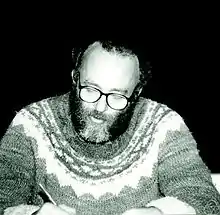Richard M. Pollack
Richard M. Pollack (January 25, 1935 – September 18, 2018)[2][3] was an American geometer who spent most of his career at the Courant Institute of Mathematical Sciences at New York University, where he was Professor Emeritus till his death. In 1986 he and Jacob E. Goodman were the founding co-editors-in-chief of the journal Discrete & Computational Geometry (Springer-Verlag).[4]
Richard M. Pollack | |
|---|---|
 | |
| Born | January 25, 1935 New York City, New York, U.S. |
| Died | September 18, 2018 (aged 83) Montclair, New Jersey, U.S. |
| Alma mater | Brooklyn College New York University |
| Known for | Weaving patterns of lines Geometric transversal theory Roadmaps of semi-algebraic sets Algorithms in real algebraic geometry Discrete & Computational Geometry (journal) |
| Scientific career | |
| Fields | Mathematics |
| Institutions | Courant Institute of Mathematical Sciences, New York |
| Doctoral advisor | Harold N. Shapiro[1] |
Contributions
In combinatorics he is known principally for his work with Paul Erdős and János Pach.[5][6][7][8] In discrete geometry he is known for a number of basic concepts and results,[9][10][11][12][13] jointly with his long-term collaborator, Jacob E. Goodman;[14] of the City College, City University of New York, and some with others.[15][16][17][18][19][20] His work with Goodman includes such results as the first nontrivial bounds on the number of order types and polytopes,[9] and a generalization of the Hadwiger transversal theorem to higher dimensions.[10] In real algebraic geometry he is known principally for a series of papers authored jointly with Saugata Basu and Marie-Françoise Roy[15][16][17][18] and for their book.[21]
Awards and honors
In 2003, a collection of original research papers in discrete and computational geometry entitled Discrete and Computational Geometry: The Goodman–Pollack Festschrift[22] was published as a tribute to Jacob E. Goodman and Richard Pollack on the occasion of their 2/3 × 100 birthdays.
In 2012 he became a fellow of the American Mathematical Society.[23]
A special memorial 556-page issue of Discrete & Computational Geometry was published in October 2020.[24]
References
- Richard M. Pollack at the Mathematics Genealogy Project
- "Richard M. Pollack".
- "Ricky Pollack", sent by Joseph S. B. Mitchell on behalf of the Computational Geometry steering committee to the compgeom-announce mailing list, September 19, 2018
- "Discrete & Computational Geometry – incl. Option to publish open access".
- Erdős, Paul; Pach, János; Pollack, Richard; Tuza, Zsolt (1989), "Radius, diameter, and minimum degree", J. Combin. Theory Ser. B, 47: 73–79, doi:10.1016/0095-8956(89)90066-x
- de Fraysseix, Hubert; Pach, János; Pollack, Richard (1990), "How to draw a planar graph on a grid", Combinatorica, 10: 41–51, doi:10.1007/BF02122694
- Pach, János; Pollack, Richard; Welzl, Emo (1993), "Weaving patterns of lines and line segments in space", Algorithmica, 9 (6): 561–571, doi:10.1007/bf01190155
- Agarwal K., Pankaj; Aronov, Boris; Pach, János; Pollack, Richard; Sharir, Micha (1997), "Quasi-planar graphs have a linear number of edges", Combinatorica, 17: 1–9, CiteSeerX 10.1.1.696.1596, doi:10.1007/bf01196127
- Goodman, Jacob E.; Pollack, Richard (1986), "There are asymptotically far fewer polytopes than we thought", Bull. Amer. Math. Soc., 46: 127–129, doi:10.1090/s0273-0979-1986-15415-7
- Goodman, Jacob E.; Pollack, Richard (1988), "Hadwiger's transversal theorem in higher dimensions", J. Amer. Math. Soc. (1): 301–309
- Goodman, Jacob E.; Pollack, Richard (1983), "Multidimensional sorting", SIAM J. Comput., 12 (3): 484–507, doi:10.1137/0212032
- Goodman, Jacob E.; Pollack, Richard (1984), "Semispaces of configurations, cell complexes of arrangements", Journal of Combinatorial Theory, Series A, 37 (3): 257–293, doi:10.1016/0097-3165(84)90050-5
- Goodman, Jacob E.; Pollack, Richard (1995), "Foundations of a theory of convexity on affine Grassmann manifolds", Mathematika, 42 (2): 305–328, CiteSeerX 10.1.1.48.3232, doi:10.1112/s0025579300014613
- "Department of Mathematics, CCNY --- People".
- Basu, Saugata; Pollack, Richard; Roy, Marie-Françoise (1996), "On the number of cells defined by a family of polynomials on a variety", Mathematika, 43: 120–126, doi:10.1112/s0025579300011621
- Basu, Saugata; Pollack, Richard; Roy, Marie-Françoise (1996), "On the combinatorial and algebraic complexity of quantifier elimination", J. ACM, 43 (6): 1002–1045, CiteSeerX 10.1.1.49.3736, doi:10.1145/235809.235813
- Basu, Saugata; Pollack, Richard; Roy, Marie-Françoise (2000), "Computing roadmaps of semi-algebraic sets on a variety", J. Amer. Math. Soc., 13: 55–82, doi:10.1090/S0894-0347-99-00311-2
- Basu, Saugata; Pollack, Richard; Roy, Marie-Françoise (2009), "An asymptotically tight bound on the number of semi-algebraically connected components of realizable sign conditions", Combinatorica, 29 (5): 523–546, arXiv:math/0603256, doi:10.1007/s00493-009-2357-x
- Goodman, Jacob E.; Pollack, Richard; Sturmfels, Bernd (1990), "The intrinsic spread of a configuration in R^d", J. Amer. Math. Soc., 3 (3): 639–651, doi:10.1090/s0894-0347-1990-1046181-2
- Cappell, Sylvain; Goodman, Jacob E.; Pach, János; Pollack, Richard; Sharir, Micha; Wenger, Rephael (1994), "Common tangents and common transversals", Advances in Mathematics, 106 (2): 198–215, doi:10.1006/aima.1994.1056
- Basu, Saugata; Pollack, Richard; Roy, Marie-Françoise (2003), Algorithms in Real Algebraic Geometry, Algorithms and Computation in Mathematics, 10, Springer-Verlag
- Discrete and Computational Geometry: The Goodman-Pollack Festschrift. Algorithms and Combinatorics. Springer. 2003. ISBN 9783540003717.
- List of Fellows of the American Mathematical Society, retrieved 2013-05-26.
- "Discrete & Computational Geometry | Volume 64, issue 3". SpringerLink. Retrieved 2020-11-26.
- Pollack, Richard (1962), Some Tauberian theorems in elementary prime number theory (Ph.D. Thesis), New York University.
- Goodman, Jacob E.; Pach, János; Pollack, Richard, eds. (2008), Surveys on Discrete and Computational Geometry: Twenty Years Later, Contemporary Mathematics, 453, Amer. Math. Soc..
